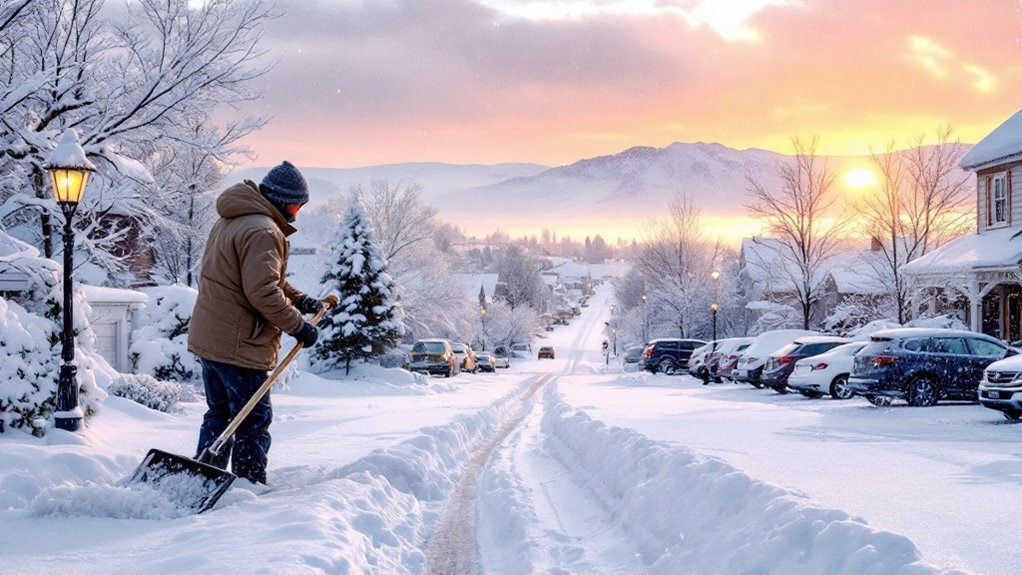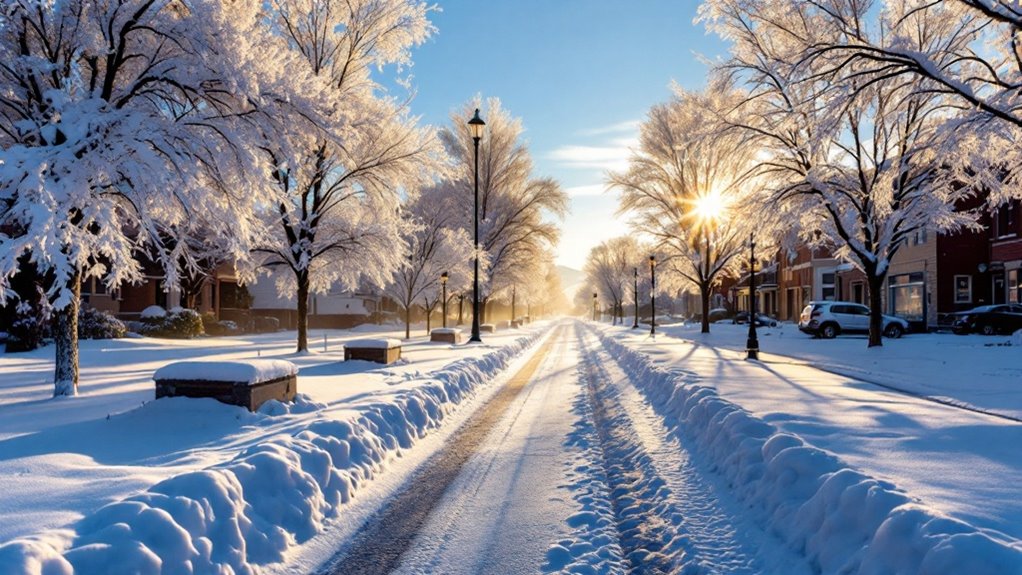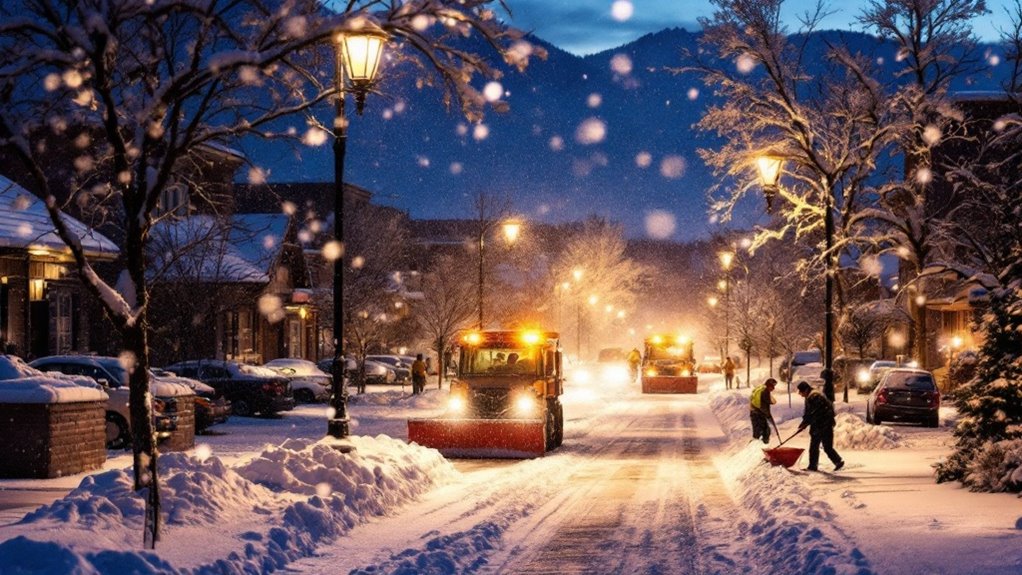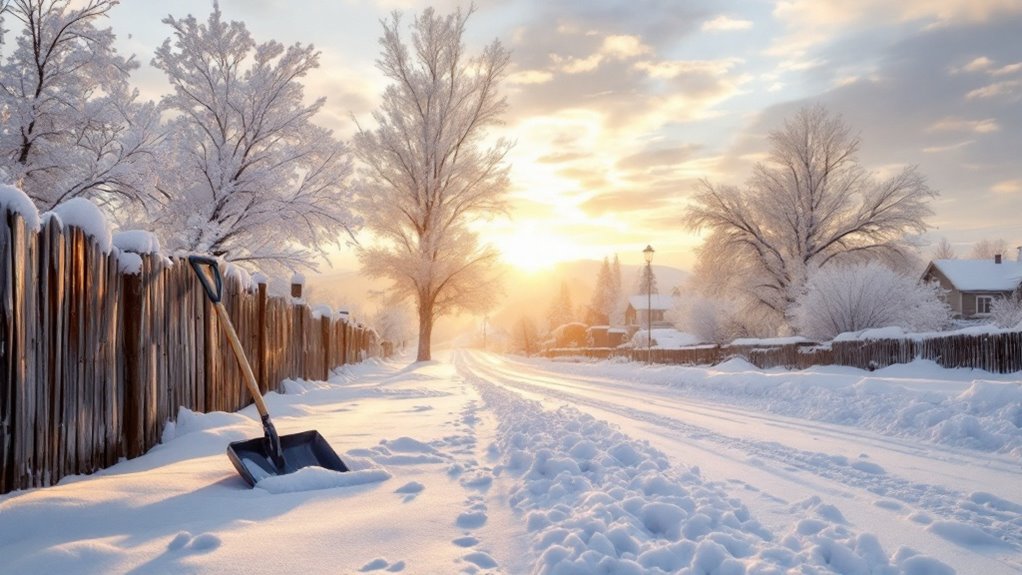You’ll find the most effective snow removal in Helena during three key time windows. Early morning hours (3-7 AM) offer minimal traffic interference and favorable conditions for anti-icing materials to work before traffic disperses them. Mid-day clearing (10 AM-2 PM) takes advantage of sun exposure that softens packed snow, making it easier to clear while maintaining ideal snow density. Evening operations (7-11 PM) benefit from reduced traffic and allow for strategic pre-treatment before overnight temperature drops. Understanding Helena’s specific weather patterns and traffic flow will help you maximize your snow removal efficiency throughout the winter season.
Key Takeaways
- Early morning clearing from 3 AM – 7 AM is optimal in Helena due to minimal traffic and consistently cold temperatures.
- Pre-dawn preparation between 11 PM – 4 AM ensures equipment and materials are ready for morning snow removal operations.
- Mid-day removal becomes effective when sunlight warms and softens packed snow, making it easier to clear completely.
- Evening operations benefit from reduced traffic and allow crews to prepare surfaces before overnight temperature drops.
- Nighttime clearing should be avoided when possible, as extreme cold reduces de-icer effectiveness and can damage equipment.
Early Morning Snow Clearing Benefits

While many residents are still asleep, Helena’s early morning snow removal operations provide indispensable advantages for the city’s daily functions. You’ll find that crews working between 3 AM and 7 AM can implement ideal snow removal methods before rush hour traffic begins, ensuring clear roads for your morning commute. The pre-dawn timing also allows plows to navigate streets more safely with minimal vehicular interference.
Early morning temperatures typically remain below freezing, making it easier to execute efficient snow clearing techniques. You’ll notice the snow’s consistency is often drier and lighter during these hours, which reduces equipment strain and increases removal speed. The timing also lets anti-icing materials work effectively before the day’s traffic disperses them.
You’ll benefit from cleared parking spaces and walkways when you arrive at work, and school zones will be safe for students. The early start means downtown businesses can open on schedule, while emergency vehicles maintain essential access to all city areas. This strategic timing also helps prevent the formation of hard-packed snow and ice, which would otherwise require more intensive removal efforts later.
Professional de-ice trucks operate around the clock to ensure continuous winter maintenance of commercial properties.
Mid-Day Temperature Sweet Spot
Three key factors make mid-day temperatures ideal for specific snow removal tasks in Helena. First, you’ll find that favorable sun exposure between 11 AM and 2 PM helps soften packed snow, making it easier to clear from driveways and walkways. Second, warmer temperatures during these hours improve your equipment’s performance, as snow blowers and plows work more efficiently when snow isn’t frozen solid.
Through snow density analysis, you’ll discover that mid-day conditions create the perfect balance for removal. The snow becomes less icy but maintains enough structure to prevent slush formation, which can be more challenging to clear than powder. You’ll want to take advantage of this window when clearing larger areas or tackling stubborn patches that morning crews couldn’t handle.
If you’re dealing with deeper accumulation, mid-day temperatures help prevent the formation of ice layers between snow levels. This timing also allows salt and de-icing materials to work more effectively, as they penetrate the snow more readily when temperatures hover around 20-25°F, typical for Helena’s winter mid-days. Hazard markers installed by professional crews help guide snow removal equipment during reduced visibility conditions.
Evening Snow Maintenance

You’ll find fewer vehicles on Helena’s streets after dark, which makes evening snow removal more efficient despite the colder temperatures that can turn slush into ice.
Your pre-dawn preparation becomes critical as nighttime temperatures often drop below freezing, affecting how the snow pack bonds to the pavement.
If you’re operating snow removal equipment during these hours, you’ll need to adjust your techniques and increase material application rates to combat the more challenging nighttime conditions.
Our 24/7 snow services ensure continuous monitoring and response to changing weather conditions throughout the night.
Reduced Traffic After Dark
Because traffic volumes drop considerably after dark in Helena, snow removal crews can work more efficiently during evening hours. You’ll notice that after 7 PM, streets become distinctly emptier, allowing plows to cover more ground without frequent stops and starts. This reduced traffic pattern typically continues until around 5 AM, providing crews with a solid window for clearing operations.
While reduced visibility at night presents some challenges, the advantages of nighttime plowing often outweigh the drawbacks. Modern equipment comes equipped with powerful lighting systems, and operators are specifically trained for low-light conditions. You’ll find that snowfall accumulation timing often aligns well with these evening operations, as storms frequently intensify during overnight hours.
If you’re planning your commute, you can expect to see crews taking full advantage of these quieter periods. They’ll focus first on emergency routes and major arteries, then move to secondary streets as conditions permit. The combination of fewer vehicles and continuous working hours means you’re more likely to find clear roads by the time morning traffic begins.
Doctor Lawn Landscape Services has been maintaining these essential evening snow removal operations in Helena since 2001, ensuring safe winter travel for the community.
Temperature Impact at Night
Nighttime temperatures in Helena typically drop well below freezing, creating distinct challenges for snow removal operations. You’ll need to account for overnight temperature trends that can turn partially melted snow into dangerous ice sheets. When you’re planning your snow removal strategy, it’s vital to understand how cold weather impacts both equipment and surface conditions.
During evening hours, you’ll encounter these specific temperature-related challenges:
- Salt and chemical de-icers become less effective below 15°F, requiring heightened application rates
- Equipment hydraulics may respond more sluggishly due to thickening fluids in extreme cold
- Snow becomes more powdery and prone to drifting as temperatures plummet
- Metal snow removal equipment becomes more brittle and susceptible to damage
You’ll find that pre-treating surfaces before temperatures drop dramatically can help prevent ice formation. It’s indispensable to monitor weather forecasts and adjust your removal timeline accordingly. If you’re dealing with wet snow during the day, you’ll want to clear it before nightfall when refreezing occurs. Remember that equipment warm-up times increase considerably during extreme cold, so factor this into your operational planning. Professional 24/7 snow management services ensure continuous monitoring and prompt response to changing winter conditions.
Pre-Dawn Snow Preparation
Evening snow maintenance sets the stage for successful pre-dawn operations in Helena. You’ll need to monitor early snowfall patterns and prepare your equipment before the first light of day. By checking weather forecasts between 9 PM and midnight, you can anticipate accumulation and plan your pre-dawn response effectively.
| Time | Critical Action |
|---|---|
| 9 PM | Weather monitoring begins |
| 10 PM | Equipment inspection |
| 11 PM | Salt/sand inventory check |
| 3 AM | Pre-dawn equipment start |
| 4 AM | Route planning finalized |
During your pre-dawn equipment checks, you’ll want to guarantee all snow removal machinery is warmed up and functioning properly. Start your equipment at least 30 minutes before deployment to allow proper engine warming in Helena’s frigid temperatures. Check fluid levels, tire pressure, and blade conditions while there’s still time to address any issues.
You’ll find that proper preparation between midnight and 4 AM substantially reduces delays when the snow removal operation begins. Position your equipment strategically near priority routes, and keep your communication devices charged and ready. Remember to document any equipment issues or weather changes that might affect your morning operations.
Our 24/7 availability service ensures continuous monitoring and response to changing weather conditions throughout the night.
Traffic Patterns and Timing
During weekday rush hours in Helena, snow removal crews strategically schedule their operations around peak traffic times. You’ll notice these crews monitoring commute volumes and adjusting their routes based on changing road conditions throughout the day. Most snow removal operations begin well before the morning rush to guarantee major thoroughfares are clear for your daily commute.
The city’s snow removal schedule follows distinct traffic patterns that you should know about:
- Early morning (3 AM – 6 AM): Priority routes and emergency access roads receive first attention when traffic is minimal
- Mid-morning (9 AM – 11 AM): Secondary streets and residential areas are cleared after rush hour subsides
- Early afternoon (1 PM – 3 PM): Downtown business district maintenance occurs during lunch breaks
- Late evening (8 PM – 11 PM): Crews return to main arteries to prepare for overnight snowfall
You’ll want to plan your travel around these operations, particularly during heavy snowfall events. When possible, delay your departure until plows have completed their initial passes through your neighborhood, and maintain extra distance when following snow removal equipment.
Regular lot sweeping services help prevent tracked snow and ice from creating hazardous conditions in parking areas and building entrances.
Weather Forecast Planning Strategies

You’ll find essential local weather data through the National Weather Service mobile app and Helena’s dedicated Montana511.com portal. Our 24/7 snow removal teams monitor these forecasts to deploy equipment efficiently during winter storms.
Local Weather App Resources
Reliable weather apps serve as essential tools for Helena residents tracking winter storms and planning snow removal activities. You’ll find several user friendly weather apps that provide hyperlocal forecasts specifically for the Helena valley region. These apps offer customizable alerts to notify you when snow accumulation is expected, helping you prepare equipment and adjust schedules accordingly.
The National Weather Service recommends these trusted weather apps for Helena residents:
- NOAA Weather Radar Live – Provides minute-by-minute radar updates and projected snowfall amounts for your exact location
- Weather Underground – Features crowdsourced data from local weather stations throughout Helena and detailed hour-by-hour forecasts
- AccuWeather MinuteCast – Offers precise precipitation start/stop times and real-time winter storm tracking
- Montana Road Report – Integrates weather data with road conditions and plowing schedules
For ideal snow removal planning, you’ll want to enable push notifications and customize temperature thresholds within your chosen app. Consider downloading multiple apps to cross-reference forecasts, as winter weather patterns in Helena can change rapidly due to varying elevation and mountain effects. Our 24/7 snow removal services ensure prompt response when weather apps indicate incoming winter storms.
Storm Pattern Timing Analysis
When tracking winter storm patterns in Helena, understanding the typical timing of snowfall events helps you plan removal strategies more effectively. Through careful snow depth monitoring and frozen precipitation analysis, you’ll notice that Helena’s heaviest snowfalls often occur between midnight and early morning hours.
You’ll want to track these common storm timing patterns to optimize your response:
| Time Period | Storm Likelihood | Typical Accumulation | Best Response |
|---|---|---|---|
| 12am – 6am | Very High | 3-6 inches | Pre-salt at 11pm |
| 6am – 12pm | Moderate | 1-3 inches | Clear by 7am |
| 12pm – 6pm | Low | < 1 inch | Monitor only |
| 6pm – 12am | High | 2-4 inches | Clear by 9pm |
For the most eco-friendly products and effective snow removal solutions, professional landscaping services can ensure your property stays safe and accessible during winter storms.
Equipment Selection for Different Times
Selecting the right snow removal equipment in Helena depends heavily on the time of year and specific weather conditions you’re facing. Your equipment storage considerations should account for both early and late season storms, while equipment maintenance requirements will vary based on usage patterns throughout the winter months.
For ideal snow management in Helena’s varying conditions, you’ll want to match your equipment to specific time periods:
- Early Season (October-November): Use lighter equipment like push brooms and plastic shovels, as early snows are typically wet and not as dense. You’ll need to protect metal equipment from rust during these humid conditions.
- Mid-Winter (December-February): Deploy heavy-duty equipment such as metal snow shovels and snow blowers when dealing with deep, compacted snow. Store this equipment in a heated space to prevent freezing.
- Late Winter (March): Keep both heavy and light equipment ready, as March storms can bring either wet, heavy snow or lighter powder. Consider using rubber-edged tools to protect spring-softening surfaces.
- Spring Season (April): Switch to combination tools that can handle both snow and water management, as melting becomes a primary concern.
Safety During Peak Removal Hours

Three pivotal peak hours for snow removal in Helena occur during early morning (5-7 AM), mid-afternoon (2-4 PM), and evening (7-9 PM), each requiring specific safety protocols. You’ll need to address visibility concerns by wearing reflective gear and using proper lighting on your equipment during these busy times.
| Time Period | Primary Safety Focus | Required Equipment |
|---|---|---|
| 5-7 AM | Low Light Visibility | LED Headlamps & Reflective Vest |
| 2-4 PM | Traffic Management | Safety Cones & Warning Flags |
| 7-9 PM | Night Operations | Strobe Lights & Reflectors |
| Emergency | All Conditions | First Aid Kit & Communication Device |
Before starting your snow removal tasks, you’ll want to complete an equipment maintenance check. Guarantee your machine’s lights are functioning, brakes are responsive, and all safety features are operational. During peak hours, you should maintain a slower pace and increased awareness of pedestrians and vehicles.
When working in reduced visibility conditions, you’ll need to take frequent breaks to prevent fatigue and maintain situational awareness. Keep your phone charged and readily accessible for emergency communications, and always work with a partner during these high-traffic periods.
Frequently Asked Questions
How Long Should I Let Snow Accumulate Before Starting to Remove It?
You shouldn’t let snow accumulate beyond 2-3 inches before starting removal. This ideal snow depth makes clearing easier, prevents ice buildup, and reduces strain on your equipment and body.
What’s the Best Way to Prevent Ice Dams While Removing Snow?
As winter’s white blanket settles, you’ll need to rake snow off your roof edges while it’s fresh. Keep gutters clear, check roof condition regularly, and safeguard proper attic ventilation to prevent ice dams.
Are There Local Noise Ordinances Restricting Snow Removal Times in Helena?
You’ll need to check local government regulations, but Helena’s noise ordinance typically restricts loud equipment before 7 AM. Some neighborhoods have specific snow removal agreements for quieter times.
How Can I Coordinate Snow Removal Timing With My Neighbors Effectively?
Like a well-choreographed dance, you’ll want to collaborate with neighbors on snow removal schedules. Create a group chat, share equipment timing, and coordinate efforts to avoid blocking each other’s cleared paths.
Which Streets in Helena Get Priority Municipal Snow Removal Treatment?
You’ll find main arterial streets like Montana Avenue and Last Chance Gulch get cleared first, while residential side streets follow after. Check Helena’s snow removal map for your street’s priority level.
Final Thoughts
You’ll find that timing your snow removal in Helena isn’t rocket science, but it might as well be. Whether you’re scraping at 5 AM while your coffee’s still too hot, or waiting for that mythical “perfect” mid-day window, you’re probably doing it wrong. Just remember: the best time to clear snow is whenever Mother Nature gives you a break—and in Montana, that’s about as predictable as winning the lottery.
